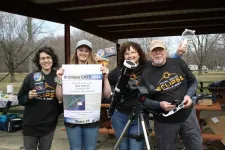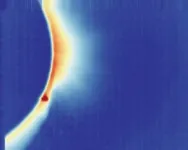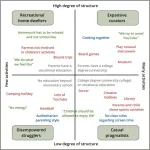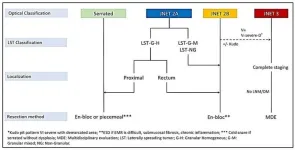(Press-News.org) SAN ANTONIO — April 22, 2024 —Teams led by Southwest Research Institute successfully executed two groundbreaking experiments — by land and air — collecting unique solar data from the total eclipse that cast a shadow from Texas to Maine on April 8, 2024. The Citizen Continental-America Telescopic Eclipse (CATE) 2024 experiment engaged more than 200 community participants in a broad, approachable and inclusive attempt to make a continuous 60-minute high-resolution movie of this exciting event. A nearly simultaneous investigation used unique equipment installed in NASA’s WB-57F research aircraft to chase the eclipse shadow, making observations only accessible from a bird’s eye view.
“Total solar eclipses are relatively rare, offering unique opportunities for scientists to study the hot atmosphere above the Sun’s visible surface,” said Dr. Amir Caspi, principal investigator of both projects. “But more than that, through CATE 2024, the eclipse offered a bonding experience between scientists and communities along the path, sharing in this incredible awe-inspiring event. We hope the public experienced a new interest in, and appreciation of, the Sun and its mysteries.”
Total solar eclipses allow scientists to view the complex and dynamic features of the Sun’s outer atmosphere in ways that aren’t possible or practical by any other means, opening new windows into our understanding of the solar corona. The faint light from the corona is usually overpowered by the intense brightness of the Sun itself, and some wavelengths of light are blocked by Earth’s atmosphere.
CATE 2024 deployed a network of 35 teams of community participants, or “citizen scientists,” representing local communities along the eclipse path, deploying a “bucket brigade” of small telescopes following the eclipse’s cross-country path. CATE 2024’s scientific objectives required measuring the polarization of light, or the orientation of oscillating light waves, in the corona.
“You are familiar with this because sometimes you wear a polarizing filter right on your face — sunglasses that filter out certain angles of polarized light,” Caspi said. “The Citizen CATE 2024 telescopes have a polarizing filter baked onto every pixel of the sensor, allowing us to measure four different angles of polarization everywhere in the corona, providing a lot more information than just measuring the brightness of the light.”
Caspi also led an airborne project to observe the corona during the eclipse from 50,000 feet. These high-altitude observations both provide measurements that can’t be made from the ground and avoid any weather-related risks. Caspi’s team deployed a new suite of sensitive, high-speed, visible-light and infrared imagers, built by the SCIFLI team at NASA’s Langley Research Center, installed in the nose cone of a WB-57 jet.
Looking at complex motion in the solar corona, at new wavelengths and with new polarization measurements, will help scientists understand why it is so hot. The corona is millions of degrees Celsius, hundreds of times hotter than the visible surface below, a curious paradox that is a longstanding scientific mystery. The corona is also one of the major sources of eruptions that cause geomagnetic storms around Earth. These phenomena damage satellites, cause power grid blackouts and disrupt communication and GPS signals, so it’s important to better understand them as the world becomes increasingly dependent on such systems.
“Combining the airborne mobile data with the CATE 2024 hour-long string of observations will provide a more complete picture of the Sun’s mysterious corona,” said SwRI co-investigator Dr. Dan Seaton, who serves as the science lead for both projects.
“Both experiments required an enormous effort and precise timing to get the data we need,” Caspi said. “I am honored and in awe of the exceptionally talented teams that worked so diligently together. I can hardly wait to dig into the data we collected.”
The SwRI-led airborne team includes scientists from the National Center for Atmospheric Research High Altitude Observatory, NASA Langley Research Center, and Predictive Sciences Inc., with collaborators at the Smithsonian Astrophysical Observatory. The SwRI-led CATE 2024 project, funded by NSF and NASA, includes scientists from the National Center for Atmospheric Research, the National Solar Observatory, the Laboratory for Atmospheric and Space Physics at the University of Colorado, and the Space Science Institute, with collaborators at New Mexico State University and the Livelihoods Knowledge Exchange Network, community leaders at Rice University, Indiana University Bloomington, and the University of Maine, and over 200 community participants in 35 communities along the eclipse path.
For more about these projects, please see: https://youtu.be/ca_GzURad1I?si=RgSjNvHBzLK0tHnC or https://eclipse.boulder.swri.edu.
For more information, visit https://www.swri.org/heliophysics.
END
SwRI-led eclipse projects shed new light on solar corona
Airborne, ground-based observations provide unique data and engage the public
2024-04-22
ELSE PRESS RELEASES FROM THIS DATE:
Analyzing the impact of ovulation-inducing agents on the quality of embryo
2024-04-22
Low birth rates have become a serious problem in many developed countries throughout the world, with Japan being a prime example. In Japan particularly, aging and stress have led to a massive rise in infertility, which now affects one in every 4.4 couples. To find a workaround this condition, many couples have now turned to assisted reproduction technologies (ARTs) and in vitro fertilization (IVF) for conception. However, even though ARTs and IVF methods are well-established and have been widely used for over four decades, birth rates post IVF in Japan are still critically low, peaking at a meager 10.2%.
One of the reasons ...
Prognostic biomarkers for hepatocellular carcinoma based on serine and glycine metabolism-related genes
2024-04-22
Background and Aims
Targeted therapy and immunotherapy have emerged as treatment options for hepatocellular carcinoma (HCC) in recent years. The significance of serine and glycine metabolism in various cancers is widely acknowledged. This study aims to investigate their correlation with the prognosis and tumor immune microenvironment (TIME) of HCC.
Methods
Based on the public database, different subtypes were identified by cluster analysis, and the prognostic model was constructed through regression analysis. The gene expression omnibus (GEO) data set was used as the ...
In psychedelic therapy, clinician-patient bond may matter most
2024-04-22
COLUMBUS, Ohio – Drug effects have dominated the national conversation about psychedelics for medical treatment, but a new study suggests that when it comes to reducing depression with psychedelic-assisted therapy, what matters most is a strong relationship between the therapist and study participant.
Researchers analyzed data from a 2021 clinical trial that found psilocybin (magic mushrooms) combined with psychotherapy in adults was effective at treating major depressive disorder.
Data included depression outcomes and participant reports about their experiences ...
Family learning environments in Scandinavia: dimensions, types and socioeconomic profiles
2024-04-22
Do children have regular bedtimes and do parents enforce strict screen time policies? And do parents take their children to museums so that they can learn from an early age? Or is everyday life more about having fun together, without clear rules and any ambition to ‘develop’ children in any particular way?
Family life can be lived in many different ways, and what children bring with them from the home environment has a substantial impact on their opportunities and development later in life.
A new study from the Department of Sociology, University of Copenhagen, and VIVE - The Danish Center for Social Science Research ...
People think 'old age' starts later than it used to, study finds
2024-04-22
Middle-aged and older adults believe that old age begins later in life than their peers did decades ago, according to a study published by the American Psychological Association.
“Life expectancy has increased, which might contribute to a later perceived onset of old age. Also, some aspects of health have improved over time, so that people of a certain age who were regarded as old in the past may no longer be considered old nowadays,” said study author Markus Wettstein, PhD, of Humboldt University in Berlin, Germany.
However, the study, which was published in the journal Psychology and Aging, also found evidence that the trend of later perceived old age has slowed ...
Afib more common and dangerous in younger people than previously thought
2024-04-22
PITTSBURGH, April 22, 2024 – Atrial fibrillation (Afib), a common type of arrhythmia that is on the rise in people under the age of 65, is more dangerous in this increasingly younger population than previously thought, according to a new study published today in Circulation Arrhythmia and Electrophysiology and authored by physician-scientists at the UPMC Heart and Vascular Institute.
The study, which is among the first to examine a large group of Afib patients younger than 65 in the U.S., found that these younger patients were more likely to be hospitalized for heart failure, stroke or heart ...
To accelerate biosphere science, reconnect three scientific cultures
2024-04-22
Researchers who study Earth’s biosphere tend to operate from one of three scientific cultures, each with distinct ways of conducting science, and which have been operating mostly independently from one another, find the authors of a Perspective published in PNAS on April 19, 2024. SFI Professors Christopher Kempes and Geoffrey West, together with External Professor Brian Enquist (University of Arizona) identify and explain the three cultures, and suggest that reconnecting them could help accelerate ...
Endoscopic techniques for removing large colorectal polyps
2024-04-22
Colorectal cancer (CRC) is the second most common cancer in the United States. This highlights the importance of early detection and treatment of precancerous lesions like large polyps. Endoscopy offers a minimally invasive approach to removing these polyps, reducing the need for traditional surgery.
This review, published in eGastroenterology, explores advancements in endoscopic resection techniques, specifically Endoscopic Mucosal Resection (EMR) and Endoscopic Submucosal Dissection (ESD).
Complete removal of large polyps (>10 mm) is crucial to prevent progression to CRC. Piecemeal resection during endoscopic procedures can increase the risk ...
Speech Accessibility Project now sharing recordings, data
2024-04-22
The Speech Accessibility Project, which aims to make automatic speech recognition technology more accessible to people with speech differences and disabilities, is now sharing some of its voice recordings and related data with universities, nonprofits and companies.
The project team is accepting signed data use agreements and one-page proposals for 211 recordings of people with Parkinson’s. The download also includes text of the original speech prompts and a transcript of the participants’ responses. A subset includes annotations ...
Scientists in Missouri, Virginia receive pediatric heart transplantation research grants
2024-04-22
DALLAS, April 22, 2024 — Scientific researchers in Missouri and Virginia have been awarded nearly $1.4 million each in grants to study ways to extend the life expectancy and improve the quality of life for children with a transplanted heart. These two research awards mark the latest round of funding for a joint $3 million scientific research initiative between the American Heart Association, celebrating 100 years of lifesaving service as the world’s leading nonprofit organization focused on heart and brain health for all, and Enduring Hearts, the only non-profit organization solely dedicated ...
LAST 30 PRESS RELEASES:
Myeloma: How AI is redrawing the map of cancer care
Manhattan E. Charurat, Ph.D., MHS invested as the Homer and Martha Gudelsky Distinguished Professor in Medicine at the University of Maryland School of Medicine
Insilico Medicine’s Pharma.AI Q4 Winter Launch Recap: Revolutionizing drug discovery with cutting-edge AI innovations, accelerating the path to pharmaceutical superintelligence
Nanoplastics have diet-dependent impacts on digestive system health
Brain neuron death occurs throughout life and increases with age, a natural human protein drug may halt neuron death in Alzheimer’s disease
SPIE and CLP announce the recipients of the 2025 Advanced Photonics Young Innovator Award
Lessons from the Caldor Fire’s Christmas Valley ‘Miracle’
Ant societies rose by trading individual protection for collective power
Research reveals how ancient viral DNA shapes early embryonic development
A molecular gatekeeper that controls protein synthesis
New ‘cloaking device’ concept to shield sensitive tech from magnetic fields
Researchers show impact of mountain building and climate change on alpine biodiversity
Study models the transition from Neanderthals to modern humans in Europe
University of Phoenix College of Doctoral Studies releases white paper on AI-driven skilling to reduce burnout and restore worker autonomy
AIs fail at the game of visual “telephone”
The levers for a sustainable food system
Potential changes in US homelessness by ending federal support for housing first programs
Vulnerability of large language models to prompt injection when providing medical advice
Researchers develop new system for high-energy-density, long-life, multi-electron transfer bromine-based flow batteries
Ending federal support for housing first programs could increase U.S. homelessness by 5% in one year, new JAMA study finds
New research uncovers molecular ‘safety switch’ shielding cancers from immune attack
Bacteria resisting viral infection can still sink carbon to ocean floor
Younger biological age may increase depression risk in older women during COVID-19
Bharat Innovates 2026 National Basecamp Showcases India’s Most Promising Deep-Tech Ventures
Here’s what determines whether your income level rises or falls
SCIE indexation achievement: Celebrate with Space: Science & Technology
Children’s Hospital Colorado performs region’s first pediatric heart and liver dual organ transplant
Australian team discover why quantum computers have memory problems over time
What determines the fate of a T cell?
Candida auris: genetic process revealed which could be treatment target for deadly fungal disease
[Press-News.org] SwRI-led eclipse projects shed new light on solar coronaAirborne, ground-based observations provide unique data and engage the public





